Keeping mice out of your Toyota Tundra can be a frustrating challenge, but with the right strategies, you can protect your vehicle from these unwanted guests, and that’s why millertoyota.net created this guide. From understanding why mice target your Tundra to implementing preventative measures and humane removal techniques, we’ll cover everything you need to know to maintain a pest-free vehicle, covering rodent prevention, car maintenance, and effective pest control. Explore our service options or contact us for personalized assistance in keeping your Tundra in top condition.
1. Why Are Mice Attracted to Toyota Tundras?
Mice are attracted to Toyota Tundras for several key reasons: seeking shelter, finding food, and nesting materials. Understanding these attractions is the first step in effective prevention.
- Warmth and Shelter: Vehicles, especially during colder months, offer a warm and secure environment. The engine bay and cabin provide protection from the elements.
- Food Sources: Crumbs, wrappers, and other food debris left inside the vehicle can attract mice. Even small amounts of food can sustain them.
- Nesting Materials: Mice use soft materials like seat cushions, insulation, and paper to build nests. The Tundra’s interior provides plenty of these options.
- Easy Access Points: Small openings and crevices in the vehicle’s structure allow mice to enter and move around undetected.
2. Identifying Mouse Problems in Your Toyota Tundra
Recognizing the signs of a mouse infestation early can prevent significant damage to your Tundra. Here are common indicators:
- Droppings: Mouse droppings are small, dark pellets often found in the cabin, glove compartment, or under the seats.
- Nesting Materials: Shredded paper, fabric, or insulation indicate that mice are building nests inside your vehicle.
- Chewed Wires: Mice often chew on wires, which can cause electrical problems or even fire hazards.
- Unusual Odors: A musty or ammonia-like smell can indicate the presence of mice and their urine.
- Scratching Noises: Hearing scratching or scurrying sounds, especially at night, suggests mice are active inside your Tundra.
- Visible Sightings: Spotting a mouse inside your vehicle, even once, confirms an infestation.
3. Essential Tools and Materials for Mouse-Proofing Your Tundra
Before you start mouse-proofing your Toyota Tundra, gather these essential tools and materials to ensure you’re well-prepared:
- Gutter Guard or Metal Screen: Use this to cover the cabin air intake and other entry points, preventing mice from entering.
- Zip Ties: Secure the gutter guard or screen in place. Heavy-duty zip ties provide a strong and reliable hold.
- Shop Vacuum: Clean out any existing debris, droppings, and nesting materials from your Tundra.
- 14mm Socket & Wrench: Needed to remove the windshield wipers and plastic cowling for access to the cabin air intake.
- Philips Screwdriver: Remove plastic clips and screws holding the cowling in place.
- Tin Snips or Die Grinder: Cut the gutter guard or metal screen to the appropriate size.
- Center Punch & Hammer: Create a starting point for drilling holes, preventing the drill bit from wandering.
- Drill & Drill Bit (3/16″ or Similar): Drill holes to attach the gutter guard or screen securely.
- Paint Pen or Marker: Mark where to drill holes on the vehicle and gutter guard for proper alignment.
- New Cabin Air Filter: Replace the existing filter to remove any contaminants and odors left by mice.
- Protective Gloves: Protect your hands from sharp edges and potential contaminants.
- Flashlight: Illuminate dark areas to inspect for mouse activity and entry points.
- Steel Wool: Stuff steel wool into small openings and crevices to block mouse entry.
- Mouse Repellent: Use a commercial mouse repellent spray or ultrasonic devices to deter mice.
- Traps (Humane): Set up humane traps to catch and remove any existing mice without harming them.
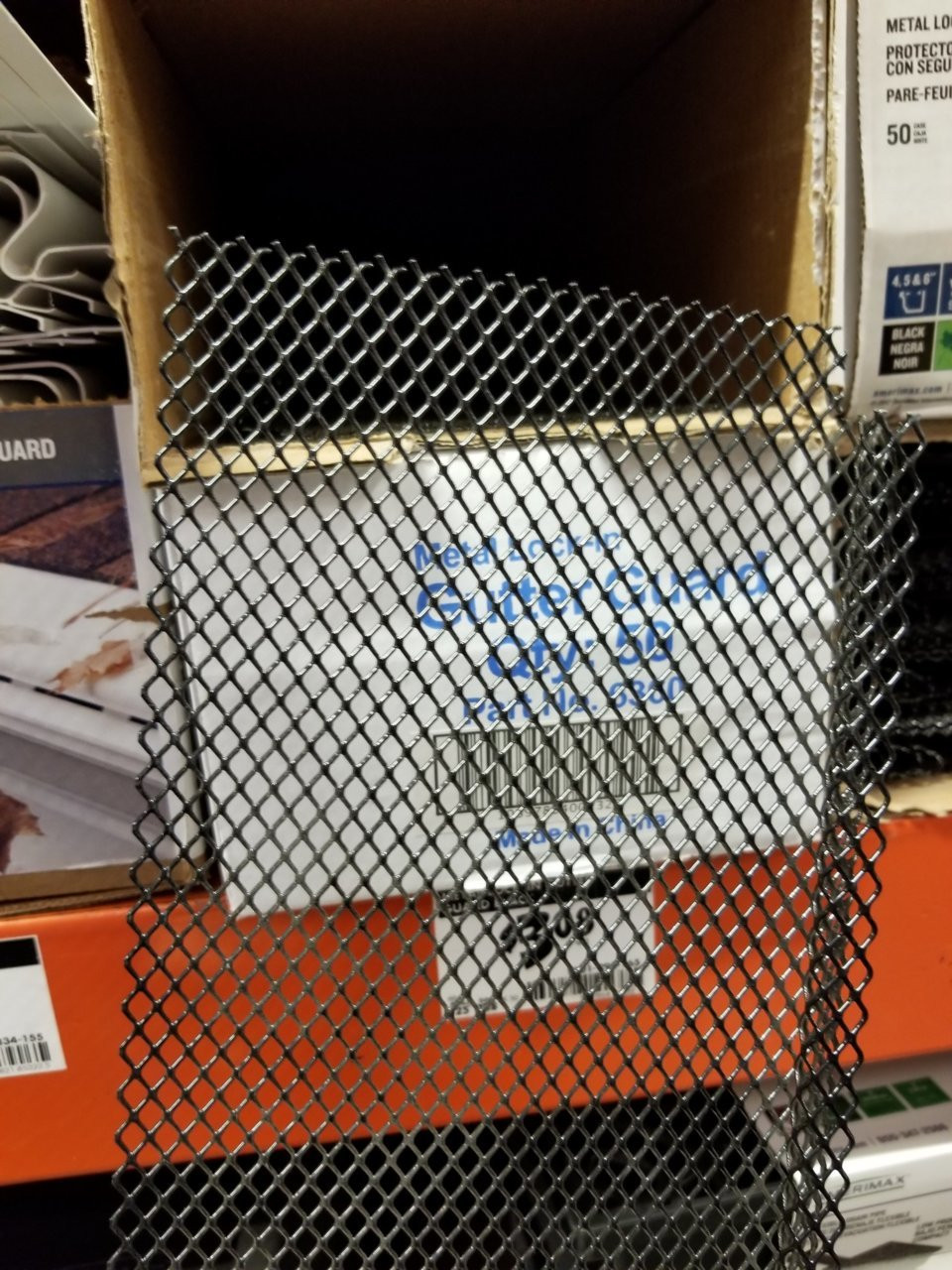 Metal gutter guard for mouse proofing
Metal gutter guard for mouse proofing
4. Step-by-Step Guide: Blocking the Cabin A/C Intake
One of the most common entry points for mice in a Toyota Tundra is the cabin A/C intake. Here’s how to block it effectively:
4.1. Preparation
- Gather Supplies: Collect all the necessary tools and materials, including gutter guard, zip ties, screwdrivers, and sockets.
- Safety First: Wear gloves to protect your hands from sharp edges and potential contaminants.
- Choose a Good Time: Plan to do this when you have ample daylight
4.2. Removing the Cowling
- Locate the Cowling: The plastic cowling is located beneath the windshield, covering the A/C intake.
- Remove Windshield Wipers: Use a 14mm socket and wrench to remove the windshield wipers.
- Detach Plastic Clips: Remove the plastic clips on each side of the cowling using a Philips screwdriver or by gently popping them out.
- Remove the Cowling: Once the wipers and clips are removed, the cowling should pop off easily. Use a shop vacuum to clean any debris.
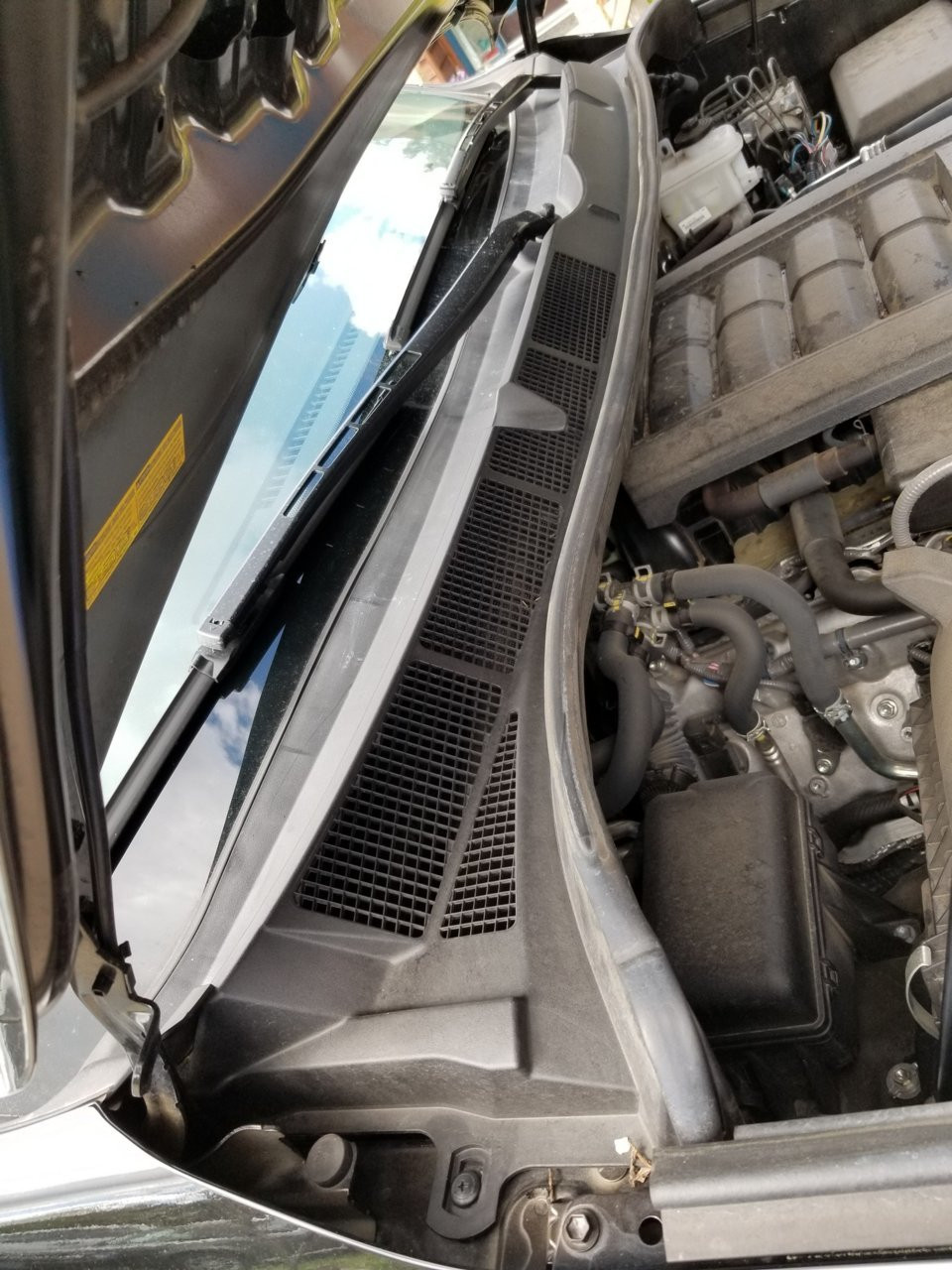 Passenger side after cowling removal for A/C intake access
Passenger side after cowling removal for A/C intake access
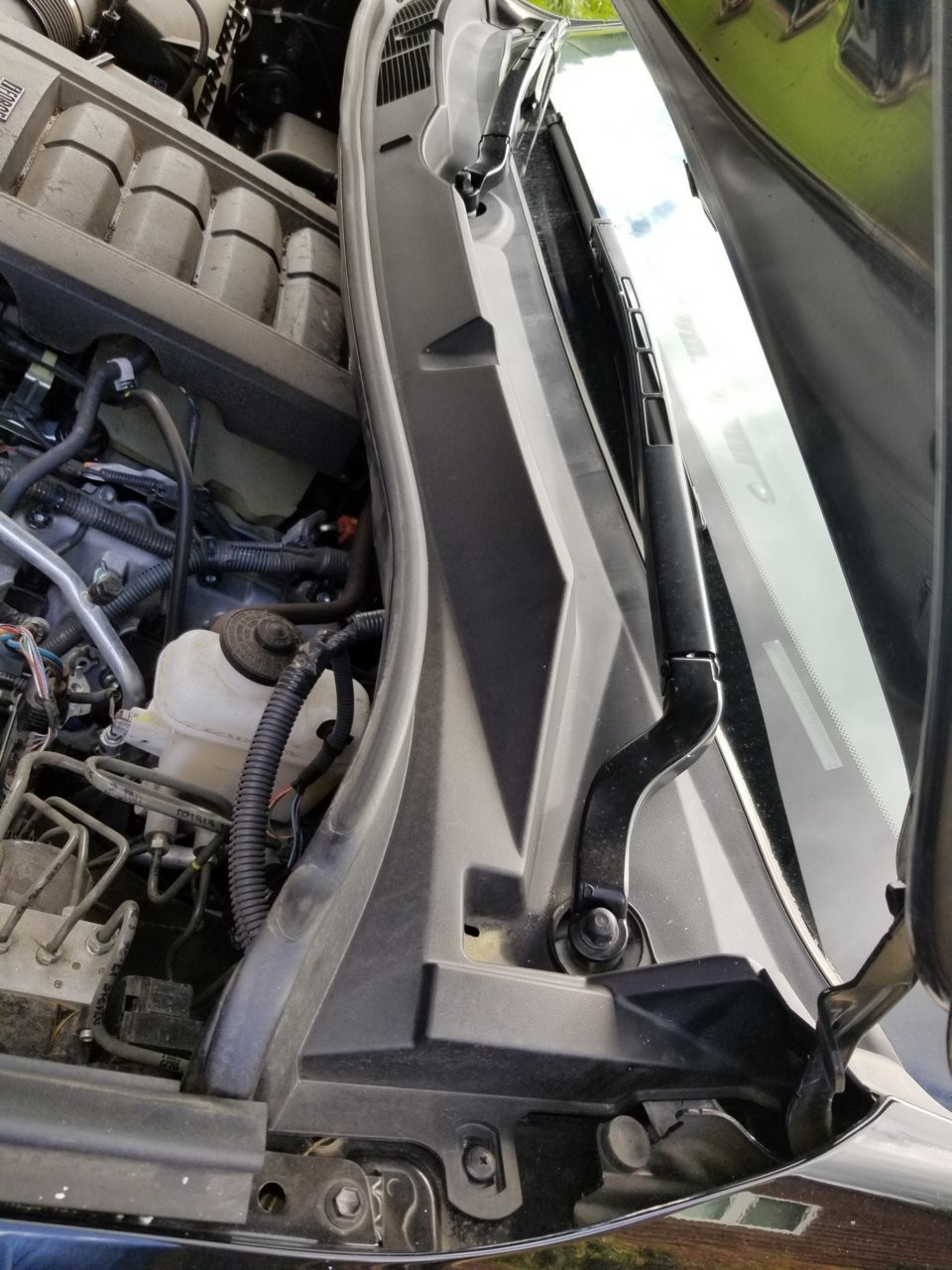 Driver side after cowling removal for A/C intake access
Driver side after cowling removal for A/C intake access
 Toyota Tundra after cowling removal
Toyota Tundra after cowling removal
4.3. Cutting the Gutter Guard
- Measure the Intake: Measure the dimensions of the A/C intake opening.
- Cut the Guard: Cut the gutter guard or metal screen to fit the opening, typically around 13″ long x 5″ tall. Tin snips, a Dremel tool, or a hacksaw will work.
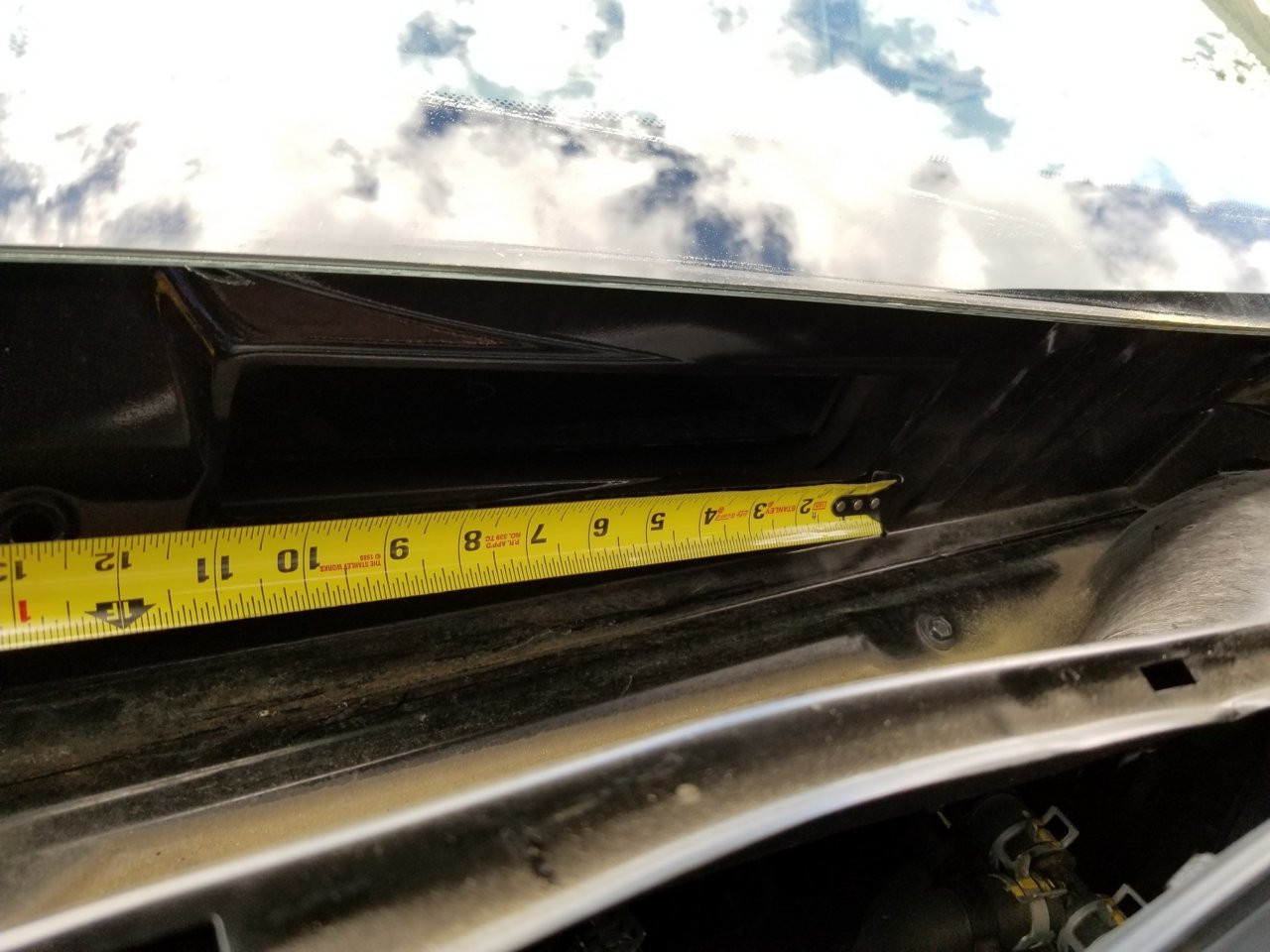 Cutting the gutter guard for A/C intake
Cutting the gutter guard for A/C intake
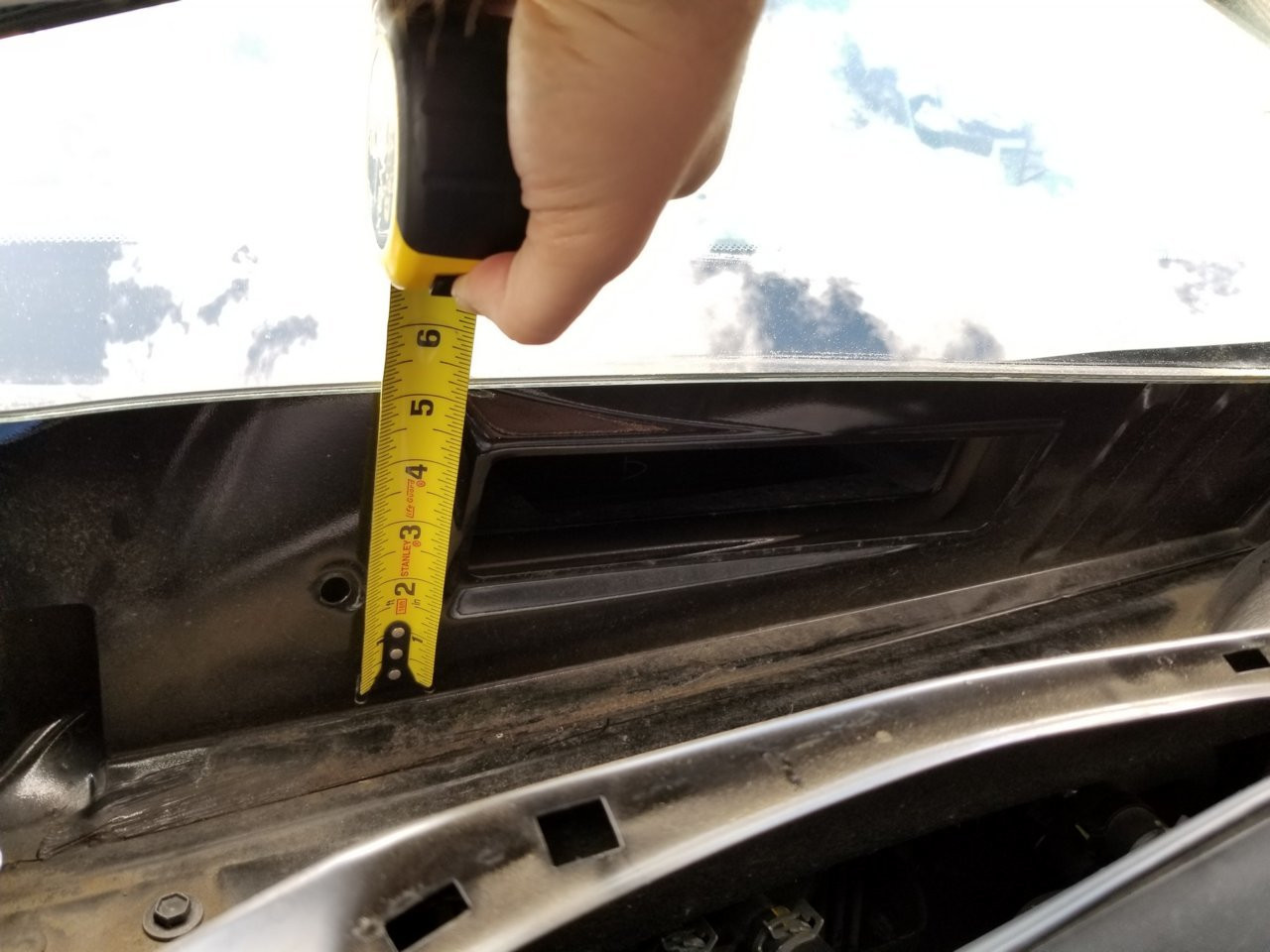 Finished cut of gutter guard
Finished cut of gutter guard
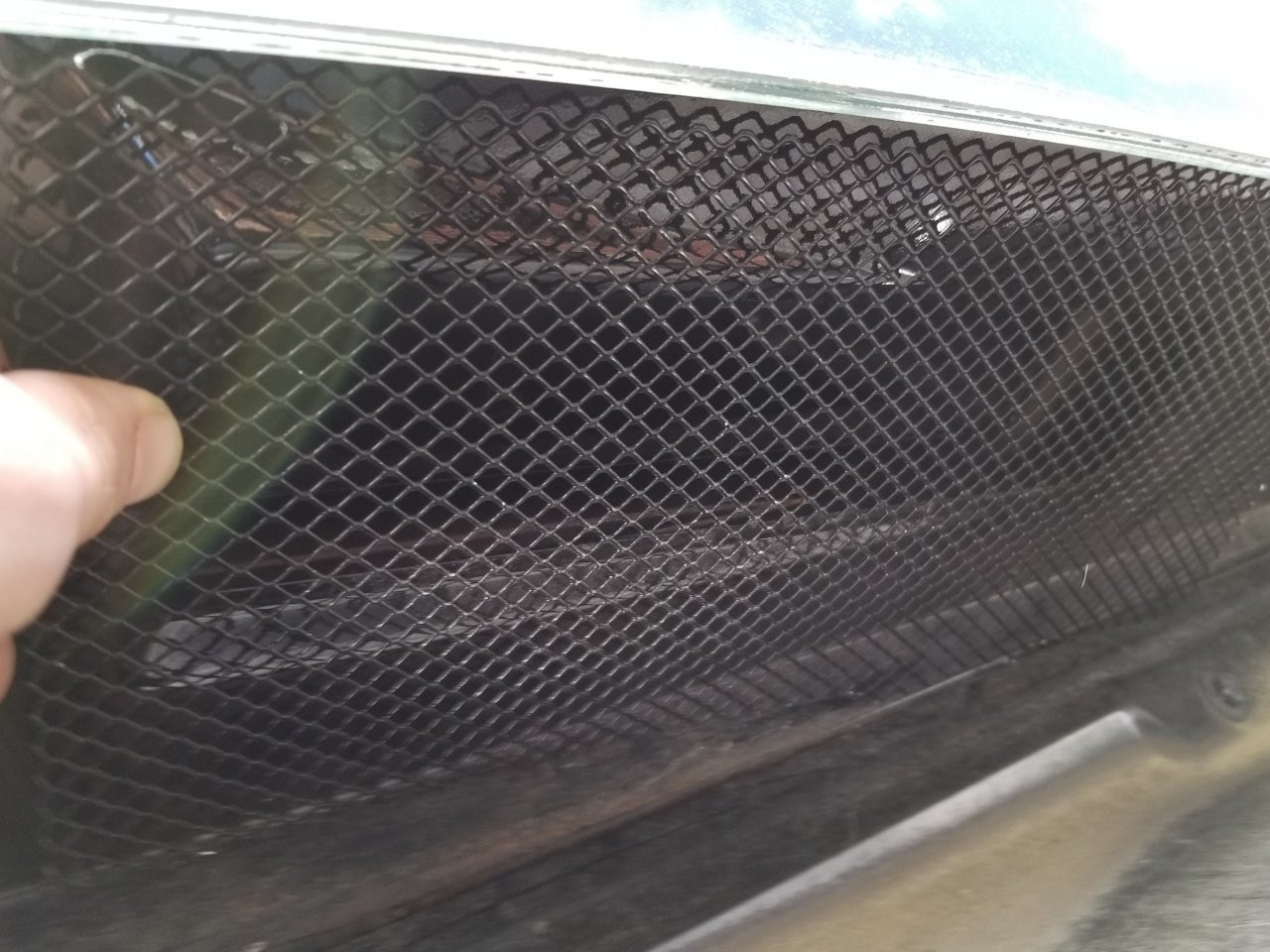 Gutter guard before installation
Gutter guard before installation
4.4. Drilling Holes
- Mark Hole Locations: Position the gutter guard over the A/C intake and mark where you will drill holes.
- Drill Holes: Use a center punch and hammer to create a starting point, then drill holes around the intake.
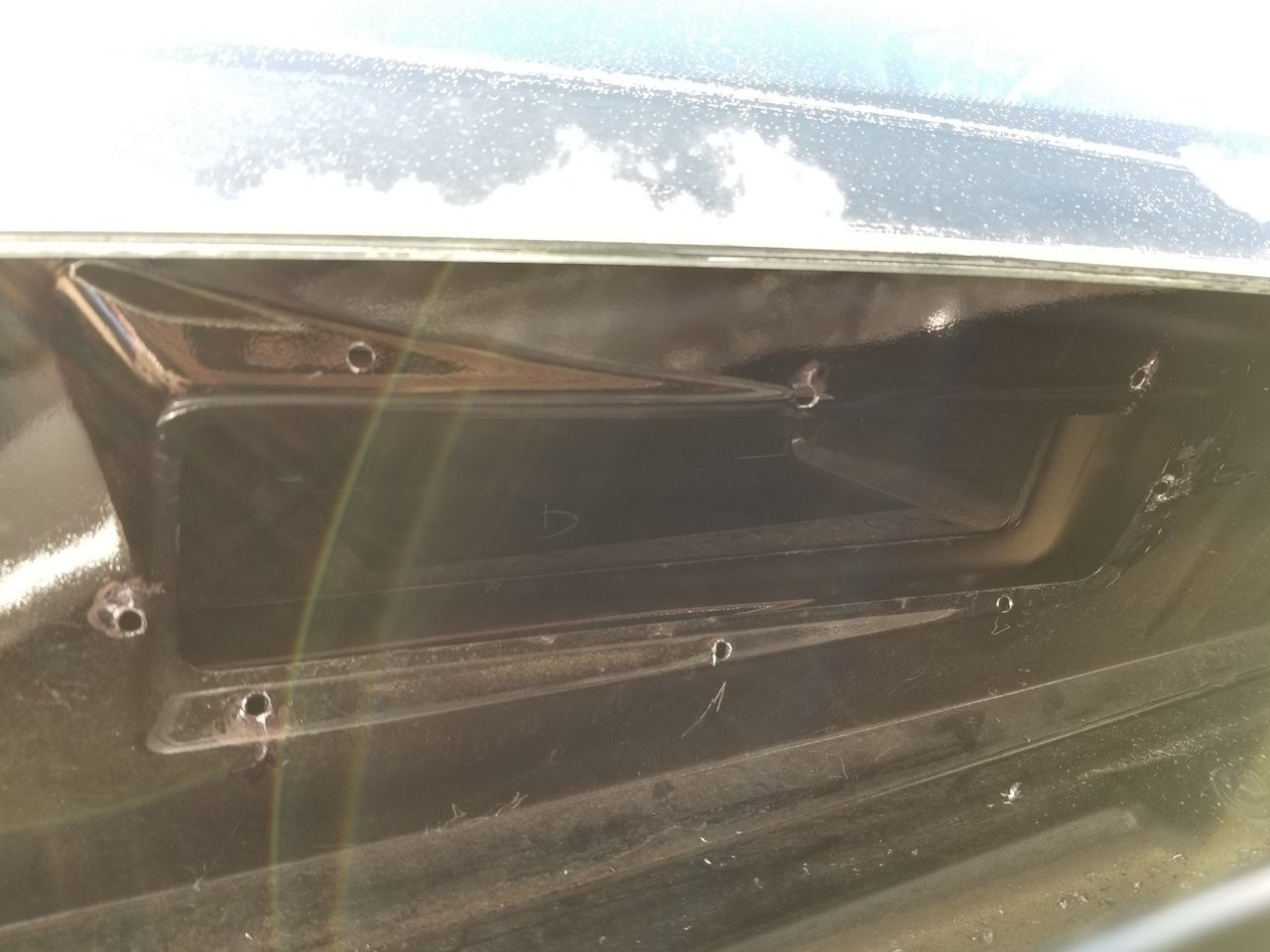 Drilling holes for gutter guard
Drilling holes for gutter guard
4.5. Attaching the Gutter Guard
- Align the Guard: Line up the gutter guard over the drilled holes.
- Secure with Zip Ties: Thread zip ties through the gutter guard and the holes, securing it tightly.
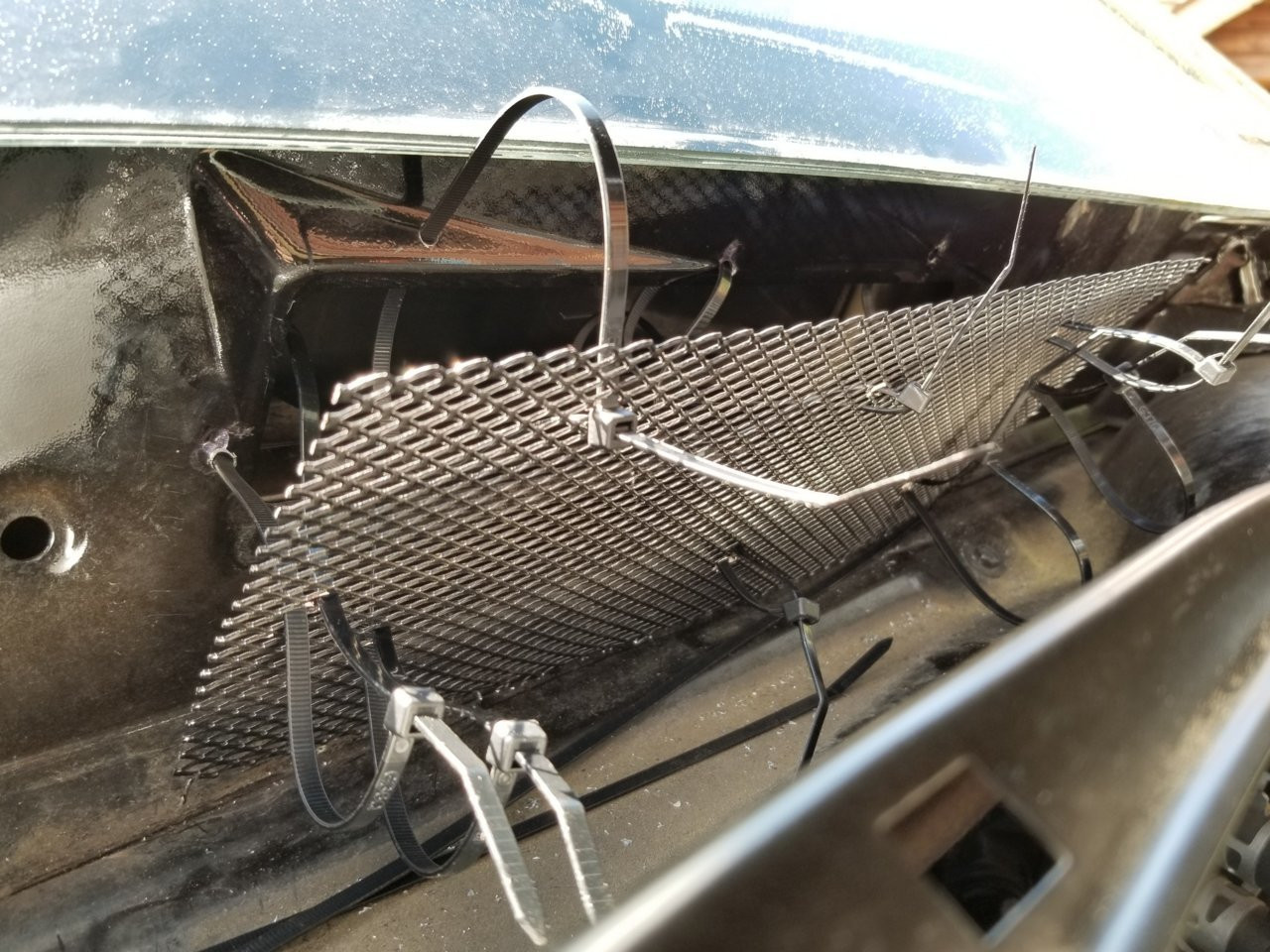 Attaching gutter guard with zip ties
Attaching gutter guard with zip ties
4.6. Finishing Up
- Trim Zip Ties: Cut off the excess zip tie length.
- Re-install Cowling: Re-install the plastic cowling and windshield wipers.
- Replace Cabin Air Filter: Remove and replace your cabin air filter, especially if it shows signs of contamination.
 Poop free cabin air filter
Poop free cabin air filter
5. Additional Entry Points and How to Block Them
While the A/C intake is a primary entry point, mice can also access your Tundra through other areas.
- Underbody Openings: Check for any openings or gaps in the underbody and seal them with steel wool or metal flashing.
- Wheel Wells: Inspect the wheel wells for any tears or openings in the liners. Repair or replace damaged liners.
- Engine Compartment: Seal any gaps around wiring harnesses and hoses entering the engine compartment with steel wool.
- Exhaust System: Ensure there are no gaps or holes in the exhaust system that mice could use to enter.
6. Natural and Chemical Mouse Repellents
Using repellents can deter mice from entering your Toyota Tundra. Here are some options:
6.1. Natural Repellents
- Peppermint Oil: Mice dislike the strong scent of peppermint. Soak cotton balls in peppermint oil and place them in the cabin, engine bay, and other potential entry points.
- Mothballs: The strong odor of mothballs can repel mice. Place them in a mesh bag and hang them in the vehicle. Be cautious, as mothballs can be toxic.
- Bay Leaves: Place bay leaves in areas where mice are likely to enter or nest.
- Cayenne Pepper: Sprinkle cayenne pepper around the perimeter of your vehicle and in the engine bay to deter mice.
6.2. Chemical Repellents
- Commercial Sprays: Use commercial mouse repellent sprays, available at auto parts stores. Follow the instructions carefully and apply to areas where mice are likely to enter.
- Rodent Tape: Wrap rodent-repellent tape around wiring harnesses and other vulnerable areas. This tape contains capsaicin, which deters mice from chewing.
7. Humane Mouse Trapping and Removal
If you find mice inside your Toyota Tundra, humane trapping and removal is an effective solution.
7.1. Choosing Humane Traps
- Live Traps: These traps capture mice without harming them. Bait the trap with peanut butter or oats and check it regularly.
- One-Way Door Traps: These traps allow mice to enter but not exit. They are effective for catching mice in specific areas.
7.2. Setting Up Traps
- Bait the Trap: Use peanut butter, oats, or seeds to bait the trap.
- Place the Trap: Place the trap in areas where you’ve seen mouse activity, such as near droppings or nesting materials.
- Check Regularly: Check the trap daily to see if you’ve caught a mouse.
- Release the Mouse: Release the mouse at least 100 yards away from your property in a wooded area.
8. Maintaining a Clean Toyota Tundra to Prevent Mice
Keeping your Toyota Tundra clean is crucial for preventing mouse infestations.
- Regular Cleaning: Vacuum the interior regularly to remove crumbs and debris.
- Remove Food Sources: Do not leave food wrappers or containers inside the vehicle.
- Clean Spills: Clean up any spills immediately to prevent attracting mice.
- Declutter: Remove unnecessary items that could provide nesting materials, such as paper, cloth, and trash.
9. Professional Pest Control Services
If you’re struggling to manage a mouse infestation on your own, consider hiring professional pest control services.
- Expert Inspection: Professionals can identify all entry points and assess the extent of the infestation.
- Effective Treatment: They use safe and effective methods to remove mice and prevent future infestations.
- Preventative Measures: Pest control services can offer advice on how to keep mice out of your vehicle and property.
10. Long-Term Prevention Strategies
Preventing mice from returning to your Toyota Tundra requires ongoing vigilance.
- Regular Inspections: Periodically inspect your vehicle for signs of mouse activity.
- Maintain Repellents: Replace or refresh repellents regularly to maintain their effectiveness.
- Seal Entry Points: Check and reseal any potential entry points as needed.
- Professional Check-ups: Consider regular pest control check-ups to ensure your vehicle remains pest-free.
11. Addressing Damage Caused by Mice
Mice can cause significant damage to your Toyota Tundra. Here’s how to address it:
- Chewed Wires: Replace any chewed wires to prevent electrical problems or fire hazards.
- Contaminated Air Filter: Replace the cabin air filter if it’s contaminated with droppings or urine.
- Damaged Upholstery: Clean or replace any upholstery that has been damaged by mice.
- Professional Cleaning: Consider professional cleaning services to remove odors and contaminants.
12. Understanding Your Toyota Tundra’s Vulnerabilities
Knowing the specific areas of your Toyota Tundra that are most vulnerable to mice can help you focus your prevention efforts.
- Cabin Air Intake: As mentioned earlier, this is a primary entry point.
- Wiring Harnesses: Mice often chew on wires, especially those in the engine bay and under the dashboard.
- Insulation: The insulation under the hood and inside the cabin provides warmth and nesting material for mice.
- Glove Compartment: This area can attract mice due to stored papers and other materials.
13. How Miller Toyota Can Help
At millertoyota.net, we offer a range of services to help you maintain your Toyota Tundra and protect it from pests.
- Vehicle Maintenance: Our expert technicians can inspect your vehicle for potential entry points and recommend solutions.
- Parts and Accessories: We provide high-quality parts, including cabin air filters and rodent-repellent tape.
- Cleaning Services: We offer professional cleaning services to remove contaminants and odors caused by mice.
Address: 208 N Maple Grove Rd, Boise, ID 83704, United States
Phone: +1 (208) 376-8888
Website: millertoyota.net
14. Community Tips and Tricks
Learn from other Toyota Tundra owners who have dealt with mouse infestations. Here are some community-tested tips:
- Dryer Sheets: Place dryer sheets in the cabin and engine bay. Some owners swear by their effectiveness in repelling mice.
- Motion-Activated Lights: Install motion-activated lights around your parking area to deter mice.
- Elevate Your Vehicle: Park your Tundra on a raised platform or blocks to make it less accessible to mice.
15. The Role of Climate in Mouse Infestations
Climate plays a significant role in mouse infestations. Understanding how weather affects mouse behavior can help you tailor your prevention strategies.
- Winter Months: Mice seek shelter indoors during the colder months, making vehicles an attractive option.
- Seasonal Changes: Be extra vigilant during seasonal changes when mice are more likely to seek new shelter.
- Dry Climates: In dry climates, mice may seek water sources inside vehicles.
- Humid Climates: Humid conditions can encourage mold and mildew, attracting mice seeking nesting materials.
16. Legal Considerations for Pest Control
Before using any pest control methods, be aware of local regulations and restrictions.
- Pesticide Use: Some pesticides are restricted or require professional application.
- Humane Trapping: Ensure that your trapping methods comply with local animal welfare laws.
- Disposal of Mice: Follow local guidelines for disposing of trapped mice.
17. DIY vs. Professional Pest Control: Making the Right Choice
Deciding between DIY and professional pest control depends on the severity of the infestation and your comfort level.
- DIY Benefits: DIY methods are cost-effective and allow you to address the problem immediately.
- DIY Drawbacks: DIY methods may not be as effective for severe infestations and can be time-consuming.
- Professional Benefits: Professionals have the expertise and tools to effectively remove mice and prevent future infestations.
- Professional Drawbacks: Professional services can be more expensive than DIY methods.
18. Preventing Mice During Storage
If you plan to store your Toyota Tundra for an extended period, take extra precautions to prevent mice.
- Clean Thoroughly: Clean the interior and exterior thoroughly before storing.
- Remove Food: Remove all food items and wrappers.
- Seal Entry Points: Seal any potential entry points with steel wool or metal flashing.
- Use Repellents: Place repellents inside the vehicle and around the perimeter.
- Cover the Vehicle: Use a car cover to protect your Tundra from the elements and deter mice.
19. Insurance Coverage for Mouse Damage
Check your insurance policy to see if it covers damage caused by mice.
- Comprehensive Coverage: Comprehensive coverage may cover damage caused by rodents, but it depends on the specific policy.
- Exclusions: Some policies exclude damage caused by pests.
- Filing a Claim: If your policy covers mouse damage, file a claim with your insurance company.
20. Staying Proactive and Vigilant
The key to keeping mice out of your Toyota Tundra is to stay proactive and vigilant.
- Regular Monitoring: Monitor your vehicle regularly for signs of mouse activity.
- Maintenance: Maintain your vehicle to prevent potential entry points.
- Cleanliness: Keep your vehicle clean to eliminate food sources and nesting materials.
- Professional Assistance: Don’t hesitate to seek professional help if you’re struggling to manage a mouse infestation.
21. Toyota Tundra Specific Tips
Because the Toyota Tundra is unique, there are specific steps you can take to help keep mice away from your car.
- Check the Frame Rails: The frame rails are hollow, and mice can use them to get into the car
- Remove Seats: Remove seats that have cloth in them for a deep and thorough cleaning
- Check the Tailgate: Because the tailgate is often open, mice can use the open access to climb aboard the vehicle.
22. Environmental Factors
- Weather: As temperatures drop, mice are looking for warmer environments. They will start exploring, and your Toyota Tundra could be the perfect spot.
- Nearby Vegetation: Untrimmed bushes or plants can be a freeway for mice. Keep vegetation trimmed away from your vehicle.
- Construction: New construction will often send rodents scurrying. If there’s construction in your neighborhood, you need to be extra careful.
23. Advanced Techniques
- Professional Detailing: Consider having your car professionally detailed to eliminate any lingering odors or food particles.
- Ozone Treatment: Ozone treatment can help eliminate odors and kill bacteria, making your car less attractive to mice.
- Undercoating: Consider an undercoating that seals the bottom of your vehicle, preventing mice from getting in.
24. The Impact of Landscaping
Your landscaping choices can significantly impact the likelihood of a mouse infestation.
- Keep Grass Short: Short grass makes it harder for mice to hide and approach your vehicle undetected.
- Remove Debris: Remove piles of leaves, wood, and other debris that can provide shelter for mice.
- Use Mouse-Repelling Plants: Consider planting mouse-repelling plants, such as mint and lavender, around your parking area.
25. The Importance of Regular Car Washes
Regular car washes can help prevent mice by removing potential food sources and keeping your vehicle clean.
- Exterior Wash: Wash the exterior of your vehicle to remove dirt, debris, and potential food particles.
- Interior Cleaning: Vacuum the interior and clean surfaces to eliminate crumbs and spills.
- Engine Bay Cleaning: Periodically clean the engine bay to remove debris and potential nesting materials.
26. Sound and Vibration Deterrents
Using sound and vibration deterrents can help keep mice away from your Toyota Tundra.
- Ultrasonic Devices: Install ultrasonic devices in your garage or parking area to emit high-frequency sounds that repel mice.
- Vibration Emitters: Use vibration emitters to create vibrations that deter mice from approaching your vehicle.
- Wind Chimes: Hang wind chimes near your parking area to create noise that deters mice.
27. Sealing Your Garage
If you park your Toyota Tundra in a garage, sealing the garage can help prevent mice from entering.
- Seal Cracks and Gaps: Seal any cracks and gaps in the walls and foundation of your garage.
- Install Door Sweeps: Install door sweeps on garage doors to prevent mice from entering.
- Cover Vents: Cover vents with wire mesh to prevent mice from entering.
28. Understanding Mouse Behavior
Understanding mouse behavior can help you develop more effective prevention strategies.
- Nocturnal Activity: Mice are most active at night.
- Constant Gnawing: Mice constantly gnaw to keep their teeth from growing too long.
- Territorial: Mice are territorial and establish pathways and nesting areas.
- Rapid Reproduction: Mice can reproduce quickly, leading to rapid infestations.
29. The Role of Lighting
Proper lighting can deter mice from approaching your Toyota Tundra.
- Exterior Lighting: Install bright exterior lights to illuminate your parking area.
- Motion-Activated Lights: Use motion-activated lights to startle mice and deter them from approaching.
- Interior Lighting: Leave a light on inside your vehicle to deter mice.
30. The Power of Scent Deterrents
Using scent deterrents can help keep mice away from your Toyota Tundra.
- Essential Oils: Use essential oils like peppermint, eucalyptus, and citronella to repel mice.
- Vinegar: Place bowls of vinegar near your vehicle to deter mice.
- Spices: Sprinkle spices like cinnamon, cloves, and cayenne pepper around your vehicle to repel mice.
31. Parking Strategies
Your parking strategies can significantly impact the likelihood of a mouse infestation.
- Avoid Parking Near Vegetation: Avoid parking near bushes, trees, and other vegetation that can provide shelter for mice.
- Park in Well-Lit Areas: Park in well-lit areas to deter mice from approaching.
- Move Your Vehicle Regularly: Move your vehicle regularly to disrupt mouse pathways and nesting areas.
32. Collaborative Prevention Efforts
Collaborating with neighbors can help prevent mouse infestations in your community.
- Share Information: Share information about mouse prevention strategies with your neighbors.
- Coordinate Efforts: Coordinate prevention efforts to address infestations in your neighborhood.
- Community Cleanups: Organize community cleanups to remove debris and potential shelter for mice.
33. The Importance of Documentation
Documenting your prevention efforts can help you track their effectiveness and identify areas for improvement.
- Keep Records: Keep records of your prevention efforts, including dates, methods, and results.
- Take Photos: Take photos of potential entry points and signs of mouse activity.
- Track Expenses: Track your expenses for pest control supplies and services.
34. Using Technology
Leverage technology to enhance your mouse prevention efforts.
- Security Cameras: Install security cameras to monitor your parking area and detect mouse activity.
- Smart Traps: Use smart traps that send alerts when a mouse is caught.
- Pest Control Apps: Use pest control apps to track infestations and access prevention tips.
35. Review and Adapt
Regularly review and adapt your prevention strategies based on their effectiveness and changing conditions.
- Assess Results: Assess the results of your prevention efforts regularly.
- Adjust Methods: Adjust your methods based on their effectiveness and changing conditions.
- Stay Informed: Stay informed about new prevention strategies and technologies.
36. Addressing Common Misconceptions
- Myth: Mice only invade dirty cars.
- Fact: Mice are attracted to any warm, sheltered space with potential food sources, regardless of cleanliness.
- Myth: One trap is enough to solve the problem.
- Fact: A comprehensive approach involving multiple methods is more effective.
- Myth: Cats are a foolproof solution.
- Fact: While cats can deter mice, they are not always effective at eliminating infestations.
37. Staying Informed with Miller Toyota
Stay informed about the latest tips and tricks for keeping your Toyota Tundra in top condition by following millertoyota.net. We provide valuable information on vehicle maintenance, pest control, and more. Contact us today for personalized assistance and explore our service options!
FAQ: Keeping Mice Out of Your Toyota Tundra
1. Why are mice attracted to my Toyota Tundra?
Mice seek warmth, shelter, food, and nesting materials, all of which your Tundra can provide.
2. What are the signs of a mouse infestation in my car?
Look for droppings, chewed wires, nesting materials, and unusual odors.
3. How can I block the cabin A/C intake to prevent mice from entering?
Remove the cowling, cut a gutter guard to size, drill holes, and secure it with zip ties.
4. What natural repellents can I use to keep mice away?
Peppermint oil, mothballs, bay leaves, and cayenne pepper are effective natural repellents.
5. How do I set up humane mouse traps?
Bait live traps with peanut butter and place them in areas where you’ve seen mouse activity.
6. What should I do if mice have already caused damage to my Tundra?
Replace chewed wires, replace contaminated air filters, and clean or replace damaged upholstery.
7. Can Miller Toyota help me prevent mouse infestations?
Yes, we offer vehicle maintenance, parts and accessories, and cleaning services.
8. What are some community tips for preventing mice?
Use dryer sheets, install motion-activated lights, and elevate your vehicle.
9. Does my insurance cover damage caused by mice?
Check your comprehensive coverage policy for rodent damage.
10. How can I stay proactive and vigilant in preventing mice?
Regularly inspect your vehicle, maintain repellents, seal entry points, and seek professional assistance when needed.
By following these comprehensive guidelines, you can effectively protect your Toyota Tundra from mouse infestations and maintain a clean, pest-free vehicle. Visit millertoyota.net for more information and assistance!
